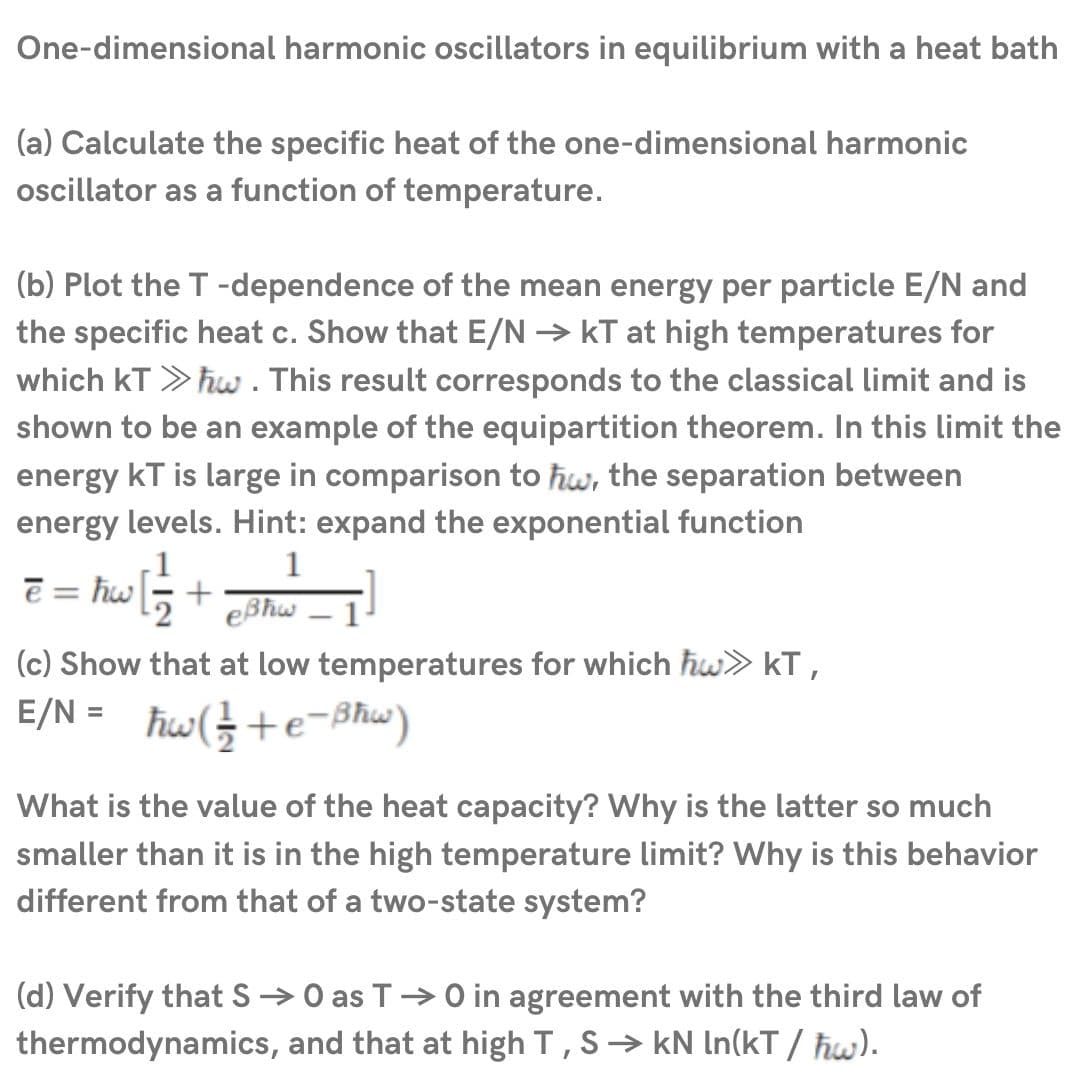One-dimensional harmonic oscillators in equilibrium with a heat bath (a) Calculate the specific heat of the one-dimensional harmonic oscillator as a function of temperature. (b) Plot the T-dependence of the mean energy per particle E/N and the specific heat c. Show that E/N → kT at high temperatures for which kT >hw . This result corresponds to the classical limit and is shown to be an example of the equipartition theorem. In this limit the energy kT is large in comparison to hw, the separation between energy levels. Hint: expand the exponential function 1 ē = hw - + eBhw (c) Show that at low temperatures for which hw> kT , E/N = hw(}+e-Phuw) What is the value of the heat capacity? Why is the latter so much smaller than it is in the high temperature limit? Why is this behavior different from that of a two-state system? (d) Verify that S→0 as T→0 in agreement with the third law of thermodynamics, and that at high T,S→ kN In(kT / Fw).
One-dimensional harmonic oscillators in equilibrium with a heat bath (a) Calculate the specific heat of the one-dimensional harmonic oscillator as a function of temperature. (b) Plot the T-dependence of the mean energy per particle E/N and the specific heat c. Show that E/N → kT at high temperatures for which kT >hw . This result corresponds to the classical limit and is shown to be an example of the equipartition theorem. In this limit the energy kT is large in comparison to hw, the separation between energy levels. Hint: expand the exponential function 1 ē = hw - + eBhw (c) Show that at low temperatures for which hw> kT , E/N = hw(}+e-Phuw) What is the value of the heat capacity? Why is the latter so much smaller than it is in the high temperature limit? Why is this behavior different from that of a two-state system? (d) Verify that S→0 as T→0 in agreement with the third law of thermodynamics, and that at high T,S→ kN In(kT / Fw).
University Physics Volume 3
17th Edition
ISBN:9781938168185
Author:William Moebs, Jeff Sanny
Publisher:William Moebs, Jeff Sanny
Chapter7: Quantum Mechanics
Section: Chapter Questions
Problem 90CP: In STM, an elevation of the tip above the surface being scanned can be determined with a great...
Related questions
Question

Transcribed Image Text:One-dimensional harmonic oscillators in equilibrium with a heat bath
(a) Calculate the specific heat of the one-dimensional harmonic
oscillator as a function of temperature.
(b) Plot the T -dependence of the mean energy per particle E/N and
the specific heat c. Show that E/N → kT at high temperatures for
which kT > hw. This result corresponds to the classical limit and is
shown to be an example of the equipartition theorem. In this limit the
energy kT is large in comparison to ħw, the separation between
energy levels. Hint: expand the exponential function
1
ē = ħw
+
eBhw
(c) Show that at low temperatures for which ħw> kT ,
E/N = hw(+e-Bhw)
What is the value of the heat capacity? Why is the latter so much
smaller than it is in the high temperature limit? Why is this behavior
different from that of a two-state system?
(d) Verify that S →0 as T> O in agreement with the third law of
thermodynamics, and that at high T,S> kN In(kT / hw).
Expert Solution
This question has been solved!
Explore an expertly crafted, step-by-step solution for a thorough understanding of key concepts.
This is a popular solution!
Trending now
This is a popular solution!
Step by step
Solved in 3 steps

Knowledge Booster
Learn more about
Need a deep-dive on the concept behind this application? Look no further. Learn more about this topic, physics and related others by exploring similar questions and additional content below.Recommended textbooks for you

University Physics Volume 3
Physics
ISBN:
9781938168185
Author:
William Moebs, Jeff Sanny
Publisher:
OpenStax

Modern Physics
Physics
ISBN:
9781111794378
Author:
Raymond A. Serway, Clement J. Moses, Curt A. Moyer
Publisher:
Cengage Learning

Classical Dynamics of Particles and Systems
Physics
ISBN:
9780534408961
Author:
Stephen T. Thornton, Jerry B. Marion
Publisher:
Cengage Learning

University Physics Volume 3
Physics
ISBN:
9781938168185
Author:
William Moebs, Jeff Sanny
Publisher:
OpenStax

Modern Physics
Physics
ISBN:
9781111794378
Author:
Raymond A. Serway, Clement J. Moses, Curt A. Moyer
Publisher:
Cengage Learning

Classical Dynamics of Particles and Systems
Physics
ISBN:
9780534408961
Author:
Stephen T. Thornton, Jerry B. Marion
Publisher:
Cengage Learning